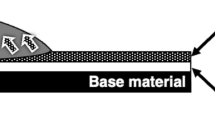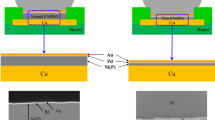Abstract
The interface gold (Au) embrittlement failure mode resulting when a Au protective finish is not completely removed by the soldering process. has been investigated This failure mode places high-reliability electronics, which use the eutectic 63Sn-37Pb (wt%, abbreviated Sn-Pb) solder and Au protective finishes, at risk for latent service failures. Part 1 documented the Au/Sn-Pb) interface microstructures and especially, Kirkendall void formation, as a function of solid-state aging. Part 2 determines the compositions of the Au-Sn IMC layers and particles using electron probe microanalysis (EPMA). Two interface IMC layers were identified: a high-Au, secondary Au-Sn IMC layer adjacent to the Au layer, and a low-Au, primary Au-Sn IMC layer next to the Sn-Pb solder. The secondary IMC layer had compositions between the δ (AuSn) and ε (AuSn2) phases. The primary IMC layer exhibited compositions between the ε (AuSn2) and η (AuSn4) phases. The compositions varied as a function of the solid-state aging parameters as well as solder layer thickness. The controlling mechanism was Kirkendall voids and their effect on Au diffusion along the Au/secondary Au-Sn IMC interface. Gold-Sn IMC particles in the solder exhibited compositions like those of the primary Au-Sn IMC layer, but were a function of Au scavenging from the Sn-Pb microstructure. Nickel diffusion, which occurred into the remaining Au and IMC layers, had a driving force that was sensitive to either solder layer thickness or the remaining Au layer thickness, the latter being correlated to the former. Gold diffusion was also measured, which took place in the Ni layer.






















Similar content being viewed by others
Notes
Unpublished data, Sandia National Laboratories, Albuquerque, NM. These data and the analysis are available upon request.
The Ni content in the Au layer was not due to “smearing” during the cross-section preparation process because of the greater hardness to the Ni layer. Measurements confirmed this premise because the Ni concentrations proved to be consistently dissimilar between thin and thick solder layer locations.
The designation, “(Au,Ni)” using the comma implies that the quantitative relationship between Au and Ni was not explicitly stated within the parentheses.
The current results did not warrant further EPMA efforts to be performed on additional test samples.
References
P.T. Vianco, Soldering Handbook, 3rd ed., (Miami: American Welding Society, 2000), p. 24.
P. Vianco, Understanding the Reliability of Solder Joints Used in Advanced Structural and Electronics Applications: Part 1, Filler Metal Properties and the Soldering Process. Welding J. Res. Supp. 96, 39 (2017).
P. Vianco, A Review of Interface Microstructures in Electronic Packaging Applications: Soldering Technology. J. Metals 71, 158 (2019).
P. Vianco, An Overview of Surface Finishes and Their Role in Printed Circuit Board Solderability and Solder Joint Performance. Circuit World 25, 6 (1998).
T. Massalski, Binary Alloy Phase Diagram (Materials Park: ASM, 1987, p. 315).
T. Massalski, ibid., p. 288
K. Denbigh, The Principles of Chemical Equilibrium, 3rd ed., (Cambridge: Cambridge University Press, 1971).
Z. Mei, P. Callery, D. Fisher, F. Hua, J. Glazer, Proc. Pacific Rim/ASME International Intersociety Elect and Photonic Pack. Conf. (1997) p.1543
J. Davis, M. Bozack, and J. Evans, Effect of (Au, Ni)Sn4 Evolution on Sn-37Pb/ENIG Solder Joint Reliability Under Isothermal and Temperature-Cycled Conditions. IEEE Trans. CPT 30, 32 (2007).
PT Vianco, A. Jerome, J. Rejent, M Grazier, SE.Garrett, SS. Sokolowski, GL. Dinger, M.K. Neilsen, L.L. Halbleib, A.C. Kilgo, R.P Grant, Qualification program for the solder interconnections of three area-array packages on copper and non-copper core, multi-layered printed circuit boards. Sandia Report SAND2015–7495 (Sandia National Laboratories, Albuquerque, NM; 2015)
P. Vianco, G. Bryant, P. Hlava, and G. Zender, Interface Reactions Between 50In–50Pb Solder and Electroplated Au Layers. Mater. Sci. Eng. A 409, 179 (2005).
Acknowledgments
The authors wish to thank Dr. Rebecca Wheeling for her thorough review of the manuscript. Sandia National Laboratories is a multi-mission laboratory managed and operated by National Technology and Engineering Solutions of Sandia LLC, a wholly owned subsidiary of Honeywell International Inc. for the U.S. Department of Energy’s National Nuclear Security Administration under contract DE-NA0003525. This paper describes objective technical results and analysis. Any subjective views or opinions that might be expressed in the paper do not necessarily represent the views of the U.S. Department of Energy or the United States Government.
Author information
Authors and Affiliations
Corresponding author
Ethics declarations
Conflict of interest
The authors declare that they have no conflict of interest.
Additional information
Publisher's Note
Springer Nature remains neutral with regard to jurisdictional claims in published maps and institutional affiliations.
Rights and permissions
About this article
Cite this article
Vianco, P.T., Kilgo, A.C., McKenzie, B.B. et al. Interface Embrittlement Between 63Sn-37Pb Solder and Au Layer. Part 2: Quantitative Compositional Analysis of Intermetallic Compound Reaction Layers. J. Electron. Mater. 52, 628–652 (2023). https://doi.org/10.1007/s11664-022-10034-w
Received:
Accepted:
Published:
Issue Date:
DOI: https://doi.org/10.1007/s11664-022-10034-w




